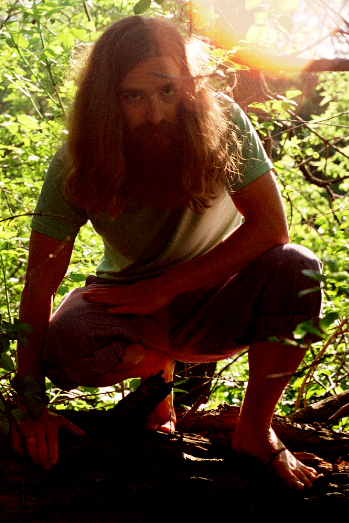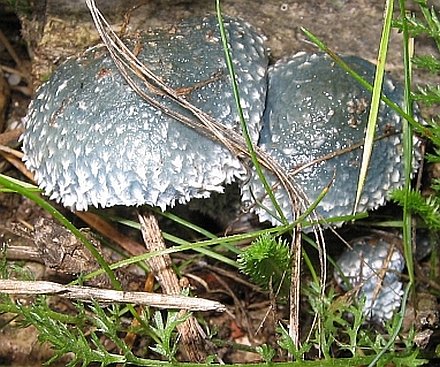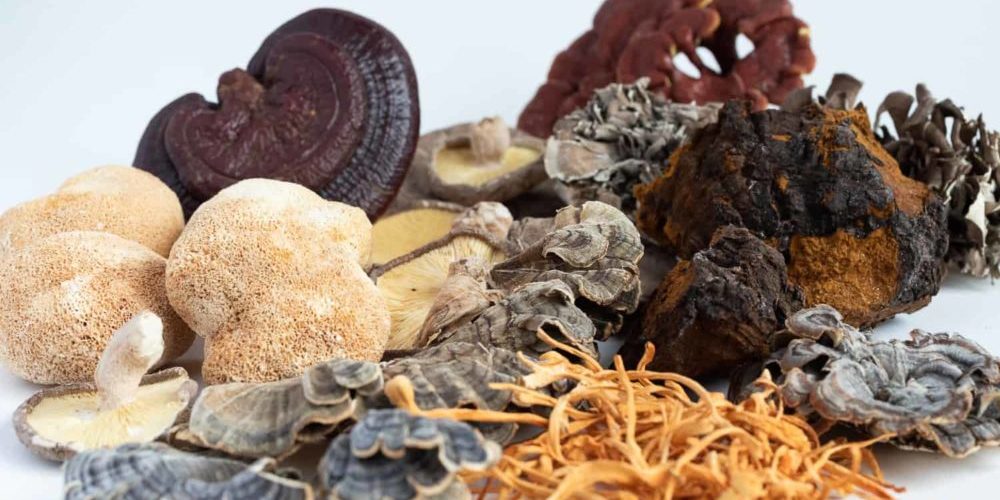One of the few green fungi, the verdigris toadstool, Stropharia aeruginosa(Curtis) Quél.
Synonyms
Agaricus aeruginosus Curtis
Fl. Londin. 2: tab. 210 (1786)
Pratella aeruginosa (Curtis) Gray
Nat. Arr. Brit. Pl. (London) 1: 626 (1821)
Psilocybe aeruginosa (Curtis) Noordel.
Persoonia 16(1): 128 (1995)
Common name
Verdigris toadstool/agaric
Blue-green stropharia
Grünspan-träuschling (German)
Kopergroenzwam (Dutch)
Description
Cap: 2-8 cm diameter, when young campanulate to convex, later plane; often with low, broad umbo, covered with verdigris-green, viscid thick gluten, sometimes dotted with white scales, especially on margin (remnants of the universal veil), in age fading to yellowish; peelable pellicle.
Flesh: white or tinged blue, rather soft, thick.
Gills: broadly adnate, sometimes emarginate–sinuate, rather broad, close, whitish at first, soon grey, finally purplish chocolate-brown, edge white and minutely floccose, subevanescent.
Stem: 5-7 cm long, 4-5 mm thick, equal, hollow, soft, concolorous with cap, viscid, at first scaly or fibrillose below the annulus.
Annulus: distant from apex, narrow, submembranous, irregularly floccose, subevanescent.
Spore print: purple-brown.
Spores: pale, smooth, thick-walled, ovoid to ellipsoid, 7-9 x 4-5 µm.
Habitat: solitary to gregarious on the ground or on rotten wood in hardwood and coniferous forests; spring to late summer; common.
Taste: indistinct, or with mildly bitter aftertaste.
Odor: weak radish smell or none.
Edibility: some sources say edible (but undesirable), others say poisonous.
Description adapted from Kaufmann, 1918; more microscopic characteristic may be gleaned from Van Crevel et al., 1988, p. 53 (as Psilocybe aeruginosa).

My name is Austin Collins.
I've dedicated my life to Mushrooms.
I believe Mushrooms are the best kept secret when it comes to health and well being.
For that reason, I would like to share a company with you that in my opinion makes the best mushroom products on the market.
The company is called Noomadic Herbals, my favorite supplement they make is called "Mushroom Total".
I take their products every day and they have helped me think better and have more energy. Give them a try.
-Austin
Bioactive compounds
Three lanostane triterpenoids, aeruginosols A, B and C, have been isolated and structurally characterized from the methanol extract of S. aeruginosa (Shiono et al., 2005; Shiono et al. 2007).
In a lipid analysis of this species (Dembitsky et al., 1992), it was found that the lipid content consisted of 47.8% total lipids (mg/g dry weight), 44.8% neutral lipids, 44.0% phospholipids, and 11.2% glycolipids. It was also reported that of the phospholipids, 32.2% was phosphatidylethanolamine, 4.4% phosphatidylserine, 50.1% phosphatidylcholine, 2.1% lysophosphatidylcholine, and 11.1% phosphatidylinositol. Further information on phospholipid and fatty acid composition may be found in this reference. In addition to these ‘garden variety’ lipids, Dembitsky et al., (1993b) reported on the occurrence of some rare hydroxy-fatty acids in this species: 0.04% (% of total lipids) 7-hydroxy-8,14-dimethyl-9-hexadecenoic acid, 0.03% 7-hydroxy-8,16-dimethyl-9-octadecenoic acid, and 0.01% 7-hydroxy-8,18-dimethyl-9-icosenoic acid.
Medicinal properties
Antitumor effects
Polysaccharides extracted from the mycelial culture of S. aeruginosa and administered intraperitoneally into white mice at a dosage of 300 mg/kg inhibited the growth of Sarcoma 180 and Ehrlich solid cancers by 70% and 60%, respectively (Ohtsuka et al., 1973).
Neuromodulatory effects
Water and ethanol extracts of S. aeruginosa caused both inhibition and excitation of impulse activity of neurons from the hippocampal stratum pyramidale (CA1 region) (Moldavan et al., 2001).
Links
References
Dembitsky VM, Rezanka T, Shubina, EE.
Chemical composition of fatty acids from some fungi.
Crypt Bot. 1993a 3(4) 383-6.
Dembitsky VM, Rezanka T, Shubina EE.
Unusual hydroxy fatty acids from some higher fungi.
Phytochem. 1993b 34(4):1057-9.
Dembitsky VM, Shubina EE, Kashin AG.
Phospholipid and fatty acid composition of some basidiomycetes.
Phytochem. 1992 31(3):845-9.
Gartz J.
Thin-layer chromatographic analysis of the constituents of fungi of the genus Stropharia.
Die Pharmazie. 1985 40(2):134-5.
Jansen PB.
The copper green fungus Stropharia aeruginosa and its relations.
Coolia. 1981 24(1):22-6.
Kauffman CH. (1918).
The Agaricaceae of Michigan. Vol 1.
Publication 26, Biological Series 5.
Kreisel H.
[Zur Taxonomie von Stropharia aeruginosa sensu lato.]
Taxonomy on Stropharia aeruginosa sensu lato.
Beihefte zur Sydowia Annales Mycologici Ser II. 1979 8:228-32.
Moldavan MG, Grodzynska GA, Wasser, SP, Storozhuk VM.
Effects of some higher Basidiomycetes extracts on the neurons activity.
Ukrayins’kyi Botanichnyi Zhurnal. 2001 58(2):220-8.
Ohtsuka S, Ueno S, Yoshikumi C, Hirose F, Ohmura Y, Wada T, Fujii T, Takahashi E.
Polysaccharides having an anticarcinogenic effect and a method of producing them from species of Basidiomycetes.
UK Patent 1331513, 26 September 1973.
Orton PD.
Notes on British agarics part 6.
Notes from the Royal Botanic Garden Edinburgh. 1976 35(1):147-54.
Shiono Y, Sugawara H, Nazarova M, Murayama T, Takahashi K, Ikeda M.
Three lanostane triterpenoids, aeruginosols A, B and C, from the fruiting bodies of Stropharia aeruginosa.
J Asian Nat Prod Res. 2007 9(6):531-5.
Shiono Y, Sugasawa H, Kurihara N, Nazarova M, Murayama T, Takahashi K, Ikeda M.
Three lanostane triterpenoids from the fruiting bodies of Stropharia aeruginosa.
J Asian Nat Prod Res. 2005 7(5):735-40.
Van Crevel R, Bas C, van Os J. (1988).
Flora Agaricina Neerlandica: Critical monographs on families of agarics and boleti occurring in the Netherlands. Vol 4. (Bas C, TH Kuyper, ME Noordeloos, EC Vellinga, Eds.).
Taylor and Francis: Rotterdam.




